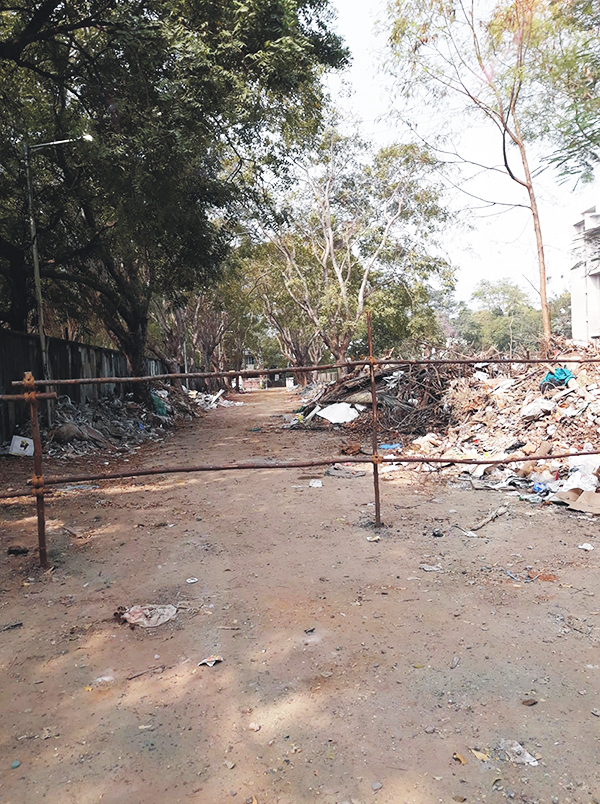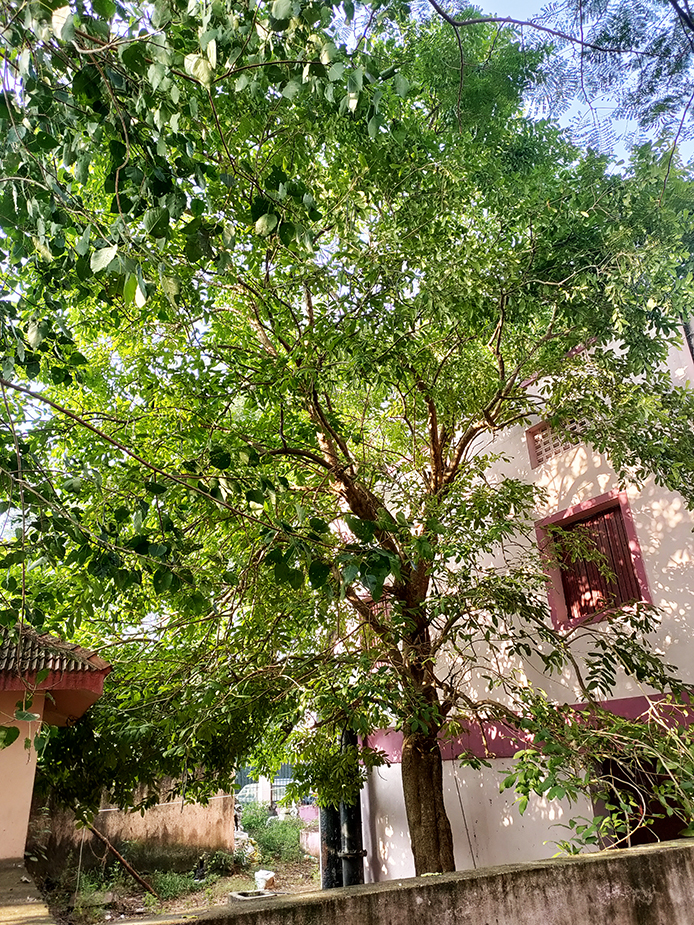Registered with the Registrar of Newspapers for India under R.N.I 53640/91
Vol. XXXII No. 21, February 16-28, 2023
Our Readers Write
Besant Nagar woes
Garbage dumping
It is gratifying to learn from media reports that Greater Chennai Corporation has launched six drones and 200 pesticide sprayers for strengthening mosquito control operation in Chennai city. It is said that the sprayers will be used for control of mosquito larvae and 3,312 workers are involved in mosquito control operations.
However, it appears that 8th Cross Street in Besant Nagar has not been identified by the drones, which has now become a mosquito breeding centre in the heart of Besant Nagar.
For the last several weeks, a huge quantity of garbage has been dumped here.

On one side of the street there is a compound wall and on the other side is the pumping station of Chennai Metropolitan Water Supply and Sewerage Board (CMWSSB). In front of the gate of the pumping station and near the dumped garbage, there is a notice board prominently exhibited by the authorities that no garbage should be dumped in the area and the violators would be punished!
This is a residential area and the dumped garbage is bound to pollute the under ground water due to seepage of toxic substances that are bound to be there in the garbage. Further, the dumped garbage inevitably leads to the generation of mosquitoes and flies. All these are potential health hazards apart from the fact that they are an eyesore for the public.
Such dumped garbage in a prominent residential area shocked one of my friends who is a foreign national visiting Chennai city when I walked along with him on the road to take him to the Rathnagireeswarar temple. It was really embarrassing for me to see his reaction.
The authorities should immediately clean the area and order an enquiry as to who has been responsible for such an unhygienic scenario.
I am attaching the photographs of the dumped garbage in the 8th Cross Street and the notice board warning that the garbage should not be dumped and violators would be punished.
* * *
Is Besant Nagar beach really clean?
As a long term resident of Besant Nagar, I read with interest the announcement by the Greater Chennai Corporation that Besant Nagar beach is judged to be the cleanest among the seven beaches in the city.
While Besant Nagar beach is certainly not as clean as it should be, this announcement speaks volumes about the level of cleanliness in other beaches in the city.
The Corporation says that 336 shops on the Besant Nagar beach sand have adopted source segregation of waste etc. and the waste is handed over to conservancy teams. Even a cursory glance on the sand would make it clear that waste materials are still seen on the sand along with waste eatables, making it uncomfortable for the visitors to sit on the sand in several places. The fact is 336 assorted shops selling various items including food items on the sand is too many in number, which the corporation is tolerating.
Apart from these 336 shops on the sand which the Corporation appear to have counted, there are a number of other carts with various items for sale including eatables that are found on the sand and the platform where visitors walk, blocking the way.
On a morning walk, I saw a number of stray dogs on the beach sand and platform and all these dogs seem to be quite healthy, nourished the thrown away eatables that are spread on the sand. With so many stray dogs, it is inevitable that their waste are also seen on the sand and sometime even on the platform.
I had the opportunity to visit a few beaches abroad, where the natural beauty is not even at half the level that Besant Nagar beach enjoys. However, the authorities there have enhanced the beauty of the beach to the extent possible by keeping it clean and tidy all the time.
I consider Elliot’s beach is one of the best beaches in the world.
While it is a fact that human efforts to beautify the beach cannot match the natural beauty, the truth is that all that is required to maintain the natural beauty of the beach is that it should be kept clean.
Finally, one cannot but miss the fact that there are a number of fish stalls in one corner of the beach, which is in an open area and is spreading bad smell around. Near the open fish stalls, there is also a public toilet which is in a very bad condition.
What I expect from Greater Chennai Corporation is that the Besant Nagar beach should be made the cleanest beach in the world, which is very much possible , if only the authorities can exhibit the required will and management capability to achieve such status.
Besant Nagar beach has all the potential and it deserves better.
N.S. Venkataraman
Trustee
Nandini Voice For The Deprived
M 60/1, 4th Cross Street
Besant Nagar
Chennai 600 090
A Friend is Saved!
On a weekend volunteering session at one of our urban forest sites, a few of us were busy preparing the ground for a new herbal garden on the side. Suddenly we heard loud noises from nearby. Many people in the neighbouring compound were pointing at a majestic Veppalai or Pala Indigo (Wrightia tinctoria) tree, our benevolent neighbour for many years now. Some official looking characters were pacing up and down. Others joined in as bystanders from convenient view points, since the commotion brought some light relief from their routine lives.
We gathered that the existing government building was to be dismantled and rebuilt. Also new housing tenements were to come up nearby. And horror of horrors, the veteran Veppalai was in their way since a half foot width of land space was ‘too costly to spare’, according to the government officials! “We can always replace with the mandated ten saplings, Madam, very soon”, said the assistant engineer in charge, rather condescendingly. And went on to “What use is a tree like this when it doesn’t even have colourful flowers or edible fruit?” Meanwhile our tree veteran stood patiently, surrounded by accumulated mounds of rubbish and litter, and unseeing eyes (whether officials or citizens)!

We had to step up immediately. Our team members went to speak to all around about the tree’s benefits, waxing eloquent on its medicinal qualities, particularly that it was revered for its quality to treat skin diseases. We noticed that people began to look almost reverently at the tree and their eyes widened with disbelief, there was a lot of murmuring that went around too. The officials in charge agreed to support. Some quick alteration of building plans was factored in, and the tree was saved!
It is about eight years on now, and our old friend continues to be gloriously magnificent, bursting into resplendent white in its blooming season and seeding bounteously soon after. And yes, we do continue to greet each other and exchange hugs!
Even as far back as 1862, in his book on timber trees of South Asia, Edward Balfour mentions the distribution of this indigenous species across the then Madras Presidency of British India especially in the Coimbatore jungles, and reports that it was ‘very common in all forests of Bombay’. He quotes William Roxburgh’s comparison of the whiteness of the wood as ‘coming nearer to ivory than any I know’. Earlier in 1824, plant specimens were presented by the British East India Company to the Royal Horticultural Society as illustrated and recorded in the botanical register founded by Sydenham Edwards and at the time published by James Ridgway.
A slow to moderate-growing plant, the Pala Indigo is a deciduous tree with a light gray, scaly smooth bark and white fragrant flowers that appear like snowflakes at a distance! It grows in a wide range of soil types ranging from arid, semi-arid, gravely or rocky soils and moist regions, especially on dry sandy sites or hillsides and valleys. The tree is harvested from the wild as a medicine and source of a dye and wood. Leaves are extracted as fodder for livestock. The seeds and bark are used in Indian traditional medicine. Native to India and Burma, Wrightia is named after a Scottish physician and botanist William Wright (1740-1827). The fruits are pendulous, long-paired, joined at their tips and its leaves yield a blue dye called Pala Indigo. About 100–200 kilos of leaves are needed to prepare 1 kilo of dye!
Known also as Sweet Indrajao, it is also referred to as Dhudi because of its preservative nature. A few drops of its sap in milk are said to prevent curdling and enhance its shelf life, without the need to refrigerate. The wood is extensively used in making cups, plates, combs, pen holders, pencils, furniture too besides in carving and lacquer work of the world famous Channapatna toys. Formerly planted as an ornamental in the tropics, it also intercrops well and branches used to be trampled into the soil in rice fields for green manuring.
– Shobha Menon

